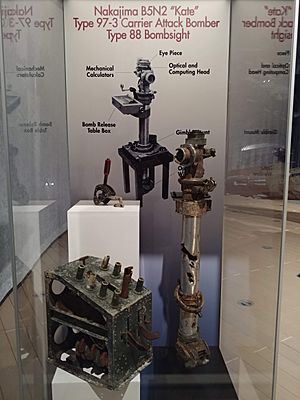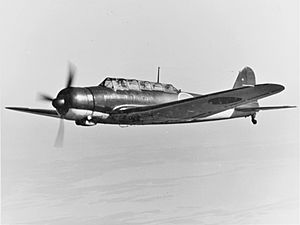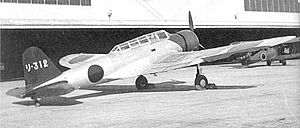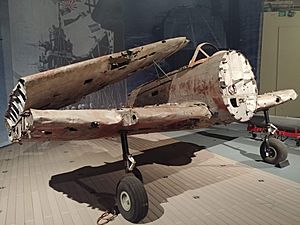Nakajima B5N facts for kids
Quick facts for kids B5N |
|
|---|---|
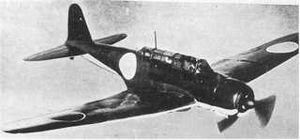 |
|
| A Nakajima B5N2 "Kate" in flight | |
| Role | Carrier-based torpedo bomber |
| National origin | Japan |
| Manufacturer | Nakajima Aircraft Company |
| First flight | January 1937 |
| Retired | 1945 |
| Status | Retired |
| Primary user | Imperial Japanese Navy Air Service |
| Number built | 1,149 |
The Nakajima B5N was a famous Japanese carrier-based torpedo bomber used during World War II. Its nickname given by the Allies was "Kate". This plane was a very important aircraft for the Imperial Japanese Navy (IJN) for most of the war.
The B5N was actually faster and more powerful than similar planes from the Allies (like the American Douglas TBD Devastator or the British Fairey Swordfish). Even though it was getting a bit old by 1941, it was still used throughout the entire war. This was because its replacement, the Nakajima B6N, took a long time to develop.
In the early part of the Pacific War, the B5N achieved great success. It was flown by highly trained Japanese pilots and took part in well-planned attacks. It played a big role in famous battles like Pearl Harbor, Coral Sea, Midway, and Santa Cruz Islands.
Contents
Designing the "Kate"
The B5N was designed by a team led by Katsuji Nakamura. The Japanese Navy asked for a new torpedo bomber in 1935 to replace an older model. Nakajima's design, called Type K, won the competition.
The very first prototype plane flew in January 1937. Soon after, it was ordered into production. Its full name was Type 97 Carrier Attack Bomber.
Making it Better: The B5N2
During the Second Sino-Japanese War, pilots found some weaknesses in the first version, the B5N1. The main problems were that the plane didn't protect its crew or its fuel tanks very well. The Navy wanted to keep the plane fast, so they didn't add heavy armor.
Instead, they tried to make a faster version. The improved B5N2 was given a much more powerful engine. This engine was the Nakajima Sakae Model 11, which was also used in the famous Mitsubishi A6M Zero fighter plane.
Some changes were made to make the plane more streamlined. Even though it was only a little bit faster, this new version replaced the B5N1 in 1939.
What was Inside the B5N?
The B5N had a crew of three: a pilot, a navigator/bombardier/observer, and a radio-operator/gunner.
The navigator's job was to guide the plane and drop bombs. They used a special device called a Type 90 bombsight. This was a long tube in the front of their seat. They also had a special reflector compass to help them navigate precisely.
The radio-operator/gunner sat behind the navigator. They used the plane's radio to communicate. This person also operated a flexible 7.7 mm machine gun at the back of the cockpit to defend the plane.
Weapons Carried
The B5N could carry different types of weapons. It could carry one Type 91 torpedo under its body. This torpedo was used to attack ships.
Instead of a torpedo, the plane could carry bombs. It could carry one large 800 kg (1,760 lb) bomb. Or, it could carry two 250 kg (550 lb) bombs, or six smaller 60 kg (132 lb) bombs. Changing between carrying a torpedo and bombs took more than two hours.
At first, most B5N bombers were painted silver. Later, before the Pacific War began, their color changed to dark green.
The "Kate" in Action
The B5N was mainly used on aircraft carriers, but sometimes it flew from land bases. A crew of three operated the plane: the pilot, the navigator/bombardier/observer, and the radio-operator/gunner. The most senior crew member, who might not be the pilot, was in charge of the mission.
The first B5N1 model was used in combat in 1938 during the Second Sino-Japanese War. The improved B5N2 played a huge role in the Attack on Pearl Harbor. For example, one B5N2 carried Mitsuo Fuchida, the leader of the attack. Another B5N2 from the carrier Hiryu is believed to have sunk the American battleship Arizona.
The B5N2 also had major successes in other battles. It helped sink the American aircraft carrier Lexington at the Battle of the Coral Sea. It also sank Hornet at the Battle of the Santa Cruz Islands. At the Battle of Midway, it badly damaged the Yorktown, which was later sunk by a Japanese submarine.
Working Together in Battle
B5N2 torpedo bombers often worked with Aichi D3A dive bombers to attack enemy carriers. The dive bombers would attack first, trying to stop the ship's anti-aircraft guns from firing. This made it safer for the slower torpedo bombers to get close and launch their torpedoes.
Later in the war, the B5N was replaced by the Nakajima B6N for front-line combat. However, B5Ns continued to be used for other jobs. These included training new pilots, towing targets for practice, and finding enemy submarines. Some even had early radars to help them.
B5Ns were also used as bombers during the defense of the Philippines in October 1944, but they suffered heavy losses. Towards the end of the war, some were even used in kamikaze attacks.
Different Versions of the B5N
- Type K: This was the very first prototype plane.
- B5N1: This was the first version that was produced in large numbers.
- B5N1-K: Many B5N1s were changed into advanced training aircraft to teach new pilots.
- B5N2: This was the improved version with a more powerful engine.
Who Used the B5N?
- Used by Indonesian guerrilla fighters after the war.
Surviving "Kate" Aircraft
Sadly, none of the 1,150 Nakajima B5N planes built survived World War II completely intact. Only two parts of B5Ns are known to exist, but neither of them can fly.
For the movie Tora! Tora! Tora!, fake B5N2s were made. They used parts from American training planes and changed them to look like the Japanese aircraft. These movie planes have been used in other films and airshows since then.
One recovered part of a B5N2 is at the Wings Museum in Balcombe, UK. This large piece was found in the Kuril Islands in 2003 by a collector.
Another B5N was put on display at the Pearl Harbor Aviation Museum in Honolulu, Hawaii, on April 18, 2016.
See also
 In Spanish: Nakajima B5N para niños
In Spanish: Nakajima B5N para niños


